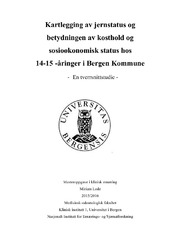Kartlegging av jernstatus og betydningen av kosthold og sosioøkonomisk status hos 14-15 -åringer i Bergen Kommune
Master thesis

Åpne
Permanent lenke
https://hdl.handle.net/1956/13028Utgivelsesdato
2016-05-15Metadata
Vis full innførselSamlinger
Sammendrag
Iron deficiency is one of the most prominent nutritional deficiencies worldwide. Despite several attempts to reduce both iron deficiency and anemia, it has become a persistent problem, also in the industrialized parts of the world. Adolescents are one of the groups who are at risk, mainly due to increased demands by growth. In particular, girls at this age are highly disposed because of a greater loss of iron through menstruation. Few studies have examined iron status of Norwegian adolescents from the last decades and this thesis will provide an updated survey by one of the largest sample investigated in Norway so far. Objective. This thesis is a part of an intervention study in which 785 students from secondary schools in Bergen municipality aged 14-15 years were invited, whereas 481 students agreed to join. We have collected venous samples of serum ferritin from 464 students. In addition we examined the importance of diet using a semi-quantitative food frequency questionnaire answered by 470 students and a second questionnaire was sent to the parents to obtain information about their socioeconomic status, whereas 374 answered. Results. Iron deficiency, defined as serum ferritin levels below 15 µg/L occurred in 9.1% of the participants. When we excluded participants who took iron supplement, the prevalence increased to 9.9%. Logistic regression analysis showed that the girls had a higher odds of developing iron deficiency compared with the boys (Odds Ratio [OR]=2.82, 95% Confidence Interval [CI]=1.38 to 5.75, P=0.004), whereas 12.8% of the girls and only 5% of the boys had concentrations of serum ferritin below 15 µg/L. There were few significant associations between the participants` diet and serum ferritin. Intake of red meat showed a weak positive correlation with serum ferritin, but only among girls (Spearman`s correlation coefficient [Rho]=0.152, P=0.018). A negative correlation between serum ferritin and consumption of dairy products was found in boys (Rho=-0.212, P=0.002). Socioeconomic status was not seen to have any decisive impact on the participants´ serum ferritin or food intake in this study population. Conclusions. This thesis suggest that iron deficiency is a declining problem among Norwegian adolescents compared with previous surveys. With every tenth middle school student suffering from iron deficiency in an affluent country like Norway, this is still not desirable. The differences in genders may suggest that a greater focus towards girls should be given in this age group. By conducting routine surveys one might be able to prevent or early detect iron deficiency and iron deficiency anemia.